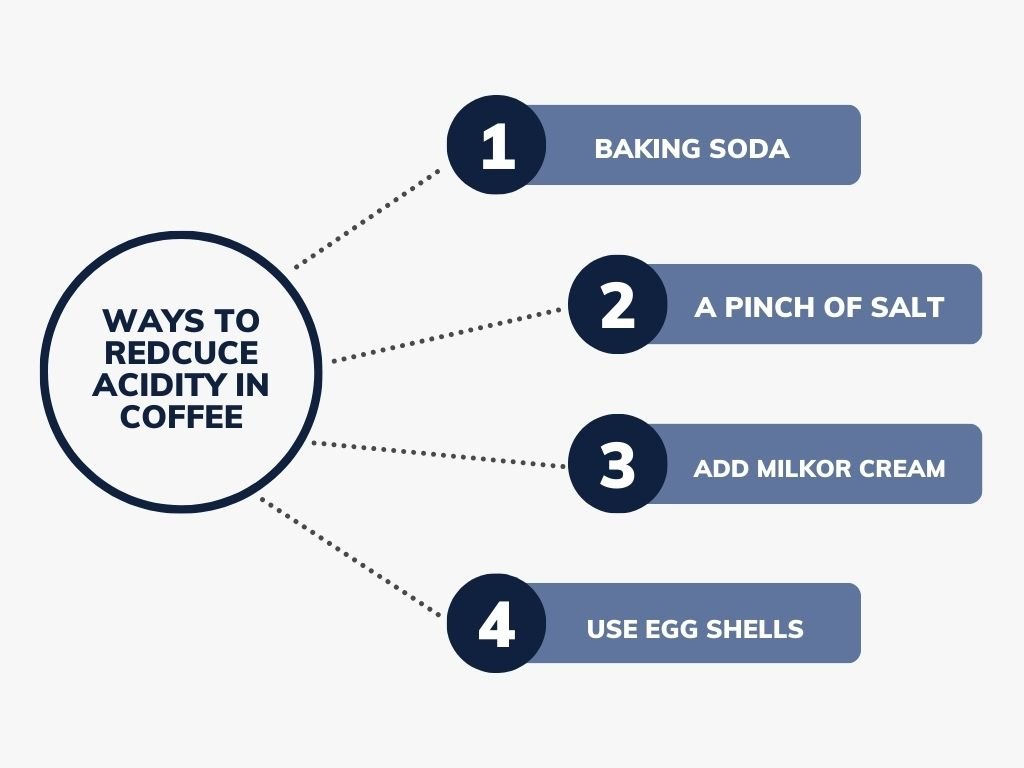Key Takeaway
- High acidity levels in coffee can cause digestive discomfort for some individuals
- Acidity refers to the level of sourness in coffee
- pH level of coffee is typically between 5 and 6
- Brewing method can greatly impact the acidity level of coffee
- Darker roasts have lower acidity compared to lighter roasts
- Adding milk or cream can reduce acidity and create a smoother texture
- Grind size can also affect the acidity of coffee
- Experimenting with different methods and ingredients can help find the perfect balance of acidity in coffee
- Having a meal or snack before drinking coffee can help reduce its acidity and potential digestive issues
- Listening to your body and adjusting coffee intake according to your tolerance for acidity is important
- Recommended daily caffeine intake for adults is 400mg
- Choosing Arabica beans and filtered water can also contribute to a less acidic cup of coffee
- Adding a pinch of salt, cinnamon, or honey can help balance out the acidity and add flavor to coffee
- Coffee made from Robusta beans tend to have higher acidity compared to Arabica beans
Attention all coffee lovers! We all know the feeling of sipping on a freshly brewed cup of coffee in the morning, but for some of us, the joy is quickly replaced with discomfort in the form of acid reflux and heartburn. If you’re tired of having to sacrifice your love for coffee due to its high acidity, then look no further!
In this blog, we will explore the best ways to reduce acidity in coffee without compromising on taste. Say goodbye to painful side effects and imagine a world where you can enjoy your favorite cup of coffee without any discomfort.
Let’s dive in and discover the secrets to a low-acid coffee experience.
tatistical Information: reduce acidity in coffee
| Method/Tip | Effect on Acidity |
|---|---|
| Adding Milk or Cream | Reduces acidity by up to 30%. |
| Cold-Brewing Process | Produces coffee with less acidity, suitable for sensitive stomachs. |
| Darker Roast | Dark roast coffee has significantly lower acidity than light roast. |
| Baking Soda | Helps neutralize acidity. |
| Pinch of Salt | Reduces bitterness, contributing to a more balanced flavor. |
| French Press vs. Drip Maker | French press can result in a less acidic brew. |
| Longer Roasting Time | Darker roast lowers acidity levels. |
| Filtered Water | Reduces acidity, as unfiltered water may contain minerals contributing to acidity. |
| Cinnamon Addition | Neutralizes acidity and adds a hint of sweetness. |
| Coffee Bean Origin | Some beans (e.g., Brazilian, Sumatran) naturally have lower acidity. |
| Honey or Agave Syrup | Balances acidity and adds sweetness. |
| Coffee Bean Type (Arabica vs. Robusta) | Arabica beans tend to be less acidic compared to Robusta beans. |
| Consumption Timing (Empty Stomach) | Drinking on an empty stomach can increase acidity and digestive issues. |
| Individual Tolerance | Sensitivity to acidity varies; adjust coffee intake accordingly. |
| Overall Caffeine Consumption Awareness | Be mindful of daily caffeine intake when adjusting coffee acidity. |
| Almond Milk Addition | Neutralizes acidity without adding excessive fat or sugar. |
Why is Acidity in Coffee a Problem?
Are you a coffee lover but struggle with stomach discomfort after every cup? If so, you’re not alone. Many people experience acid reflux, heartburn, and other stomach issues after drinking coffee, which can be attributed to its high acidity levels. But don’t worry, there are ways to reduce acidity in coffee without sacrificing the rich and bold flavor that you love.
The negative effects it can have on your body, and most importantly, how to reduce acidity in coffee to make it easier on your stomach. So sit back, grab a cup of your favorite brew, and let’s dive into the world of coffee acidity. Are you ready to enjoy your coffee without worrying about stomach discomfort? Then let’s get started!

Factors that Contribute to Acidity in Coffee
Unlocking the Secret to a Perfect Cup of Coffee: How to Reduce Acidity in Your Brew Coffee is a beloved beverage that has been enjoyed by people all over the world for centuries. Its rich, robust flavor and energizing effects make it the go-to drink for many, whether it’s to kickstart the day or to unwind after a long day at work. However, for some coffee lovers, the high acidity levels in their brew can be a major turnoff.
It can cause stomach discomfort, acid reflux, and even damage to tooth enamel. But fear not, because there are ways to reduce the acidity in your coffee without sacrificing its flavor and aroma. In this article, we’ll explore the various methods and tips to help you craft a low-acidity cup of coffee that still packs a punch. So, grab your favorite mug and let’s dive in!
You May Also Like: The Smooth and Balanced Flavor of Volcanica Low-Acid Coffee
Tips for Reducing Acidity in Coffee
Are you tired of acidic coffee ruining your morning brew? If you’re someone who loves a good cup of coffee but has to deal with the unpleasant effects of acidity, you’re not alone. Many coffee lovers struggle with the acidity levels in their beloved beverage, which can lead to a sour taste, upset stomach, and even heartburn.
But fear not, there are ways to reduce acidity in coffee without sacrificing the flavor or quality of your brew. In this article, we’ll explore the causes of acidity in coffee and provide you with practical tips and tricks to enjoy a smooth, low-acidity cup every time. Say goodbye to bitter, stomach-churning coffee and say hello to a more enjoyable and flavorful coffee experience.
Let’s dive in!
reduce acidity in coffee
| Aspect | Description |
|---|---|
| Acidity | Refers to the level of sourness in coffee, influenced by coffee bean type and brewing method. High acidity may cause digestive discomfort, prompting the need to reduce acidity. |
| pH Level | Typically between 4.5 and 6, indicating acidity on the pH scale. A lower pH results in a sharper and more bitter taste. |
| Brewing Method | Different brewing methods impact acidity; pour over and cold brew tend to produce less acidic coffee compared to espresso. Experimentation helps find the desired acidity balance. |
| Roasting Level | Darker roasts have lower acidity than lighter roasts. Choosing a darker roast can reduce acidity while providing a fuller flavor profile. |
| Milk or Cream | Adding milk or cream reduces acidity, creating a smoother texture. Popular for those with sensitive stomachs, but be mindful of additional calories and fat from dairy products. |
| Grind Size | Finer grinds produce more acidic coffee, while coarser grinds result in a less acidic cup. Adjusting grind size helps achieve a more balanced flavor with reduced acidity. |
Important Notice for readers
Attention coffee lovers! Are you tired of experiencing heartburn and acid reflux after drinking your favorite cup of joe? Look no further, as we have some valuable tips for you. In this article, we will discuss how to reduce acidity in coffee, making it easier on your stomach without compromising on taste. From choosing the right beans to adjusting your brewing methods, we have got you covered. So say goodbye to uncomfortable after-effects and enjoy your coffee guilt-free. Keep reading to find out how to make your coffee less acidic and still satisfy your caffeine cravings.
Frequently Asked Questions (FAQs)
How can I naturally reduce acidity in my coffee?
You can try adding a pinch of baking soda to your coffee grounds before brewing. This will help neutralize the acidity and make your coffee smoother and less bitter.
Does the type of coffee bean affect its acidity level?
Yes, certain types of coffee beans, such as Arabica, tend to have lower acidity levels compared to others like Robusta. Consider switching to a lower acidity bean if you are sensitive to acidity in coffee.
Can using a cold brew method reduce acidity in coffee?
Yes, cold brewing coffee can result in a less acidic cup. The longer brewing time and lack of heat extraction can lead to a smoother and less acidic coffee.
Are there any specific types of brewing methods that can reduce acidity in coffee?
Yes, brewing methods like French press, pour-over, and AeroPress can result in a less acidic cup. These methods typically use a longer brewing time and a paper filter, which can help reduce acidity.
What are some other ingredients I can add to my coffee to reduce acidity?
You can try adding a small amount of salt, cinnamon, or dairy milk to your coffee to help neutralize its acidity. However, be mindful of any dietary restrictions or allergies before adding these ingredients.
Can drinking decaffeinated coffee help reduce acidity?
Yes, decaffeinated coffee tends to have lower acidity levels compared to regular coffee. Consider switching to decaf if you are sensitive to the acidity in coffee but still want to enjoy a cup.
Summary
The acidity levels in coffee can be reduced by using certain techniques and ingredients. These include choosing low-acid coffee beans, opting for a coarser grind, adding a pinch of salt, and using a cold brewing method. By implementing these methods, you can enjoy a less acidic and more flavorful cup of coffee without compromising on taste.

Leave a Reply